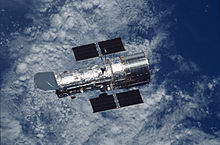- Astronautics
-
Astronautics, and related astronautical engineering, is the theory and practice of navigation beyond the Earth's atmosphere. In other words, it is the science and technology of space flight.
The term astronautics was coined by analogy with aeronautics. As there is a certain degree of technology overlapping between the two fields, the term aerospace is often used to describe them both.
As with aeronautics, the restrictions of mass, temperatures, and external forces require that applications in space survive extreme conditions: high-grade vacuum, the radiation bombardment of interplanetary space, the magnetic belts of low Earth orbit. Space launch vehicles must withstand titanic forces, while satellites can experience huge variations in temperature in very brief periods.[1] Extreme constraints on mass cause astronautical engineers to face the constant need to save mass in the design in order to maximize the actual payload that reaches orbit.
Contents
History
The early history of astronautics is theoretical: the fundamental mathematics of space travel was established by Isaac Newton in his 1687 treatise Philosophiae Naturalis Principia Mathematica.[2] Other mathematicians, such as Swiss Leonhard Euler and Italian Joseph Louis Lagrange also made essential contributions in the 18th and 19th centuries. In spite of this, Astronautics did not become a practical discipline until the mid-20th century. On the other hand, the question of space flight tickled the literary imaginations of such figures as Jules Verne and HG Wells.
At the beginning of the 20th century, Russian Konstantin Tsiolkovsky derived the famous rocket equation, the governing equation for a rocket-based propulsion. This equation makes it possible to compute the final velocity of a rocket from the mass of spacecraft(m1), combined mass of propellant and spacecraft (m0) and exhaust velocity of the propellant (ve).
For more information on the mathematical basis of space travel, see space mathematics.
By the early 1920s, the American Robert Goddard was developing liquid-fueled rockets, which would in a few brief decades become a critical component in the designs of such famous rockets as the V-2 and Saturn V.
Sub-disciplines
Although many regard Astronautics itself as a rather specialized subject, engineers and scientists working in this area must be knowledgeable about many distinct fields of knowledge.
- Astrodynamics: the study of orbital motion. Those specializing in this field examine topics such as spacecraft trajectories, ballistics and celestial mechanics.
- Spacecraft propulsion: how spacecraft change orbits, and how they are launched. Most spacecraft have some variety of rocket engine, and thus most research efforts focus on some variety of rocket propulsion, such as chemical, nuclear propulsion, or electric propulsion.
- Spacecraft design: a specialized form of systems engineering which centers on combining all the necessary sub-systems for a particular launch vehicle or satellite
- Controls: keeping a satellite or rocket in its desired orbit (as in spacecraft navigation) and orientation (as in attitude control).
- Space environment: although more a sub-discipline of Physics rather than Astronautics, the effects of space weather and other environmental issues constitute an increasingly important field of study for spacecraft designers.
Related fields of study
See also
- Aerospace
- Atmospheric reentry
- Konstantin Tsiolkovsky
- Space Race
- Robert Goddard
- Wernher von Braun
- Spacefaring
- Frank Malina
References
Categories:
Wikimedia Foundation. 2010.


